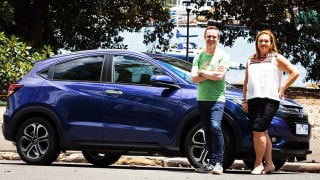
Honda HR-V VTi-L 2017 review: Torquing Heads
Nikki Cousins and Peter Anderson road test and review the Honda HR-V VTi-L, with specs, fuel consumption and verdict.
Browse over 9,000 car reviews

Kids, eh? You raise them up, you keep them safe in Mum and Dad's Corollas and Camrys. Grandma ferries them to the movies in an Echo or Yaris, the last car she ever need own. And how do they repay you for all these years of faithful service? By buying other brands', supposedly funkier mini-SUVs, abandoning the sensible option of a perfectly serviceable Toyota motor car.
Oh, sure, you tried before and brought out the Rukus. But Mum and Dad bought them when the kids left home. Grandma even considered one when she discovered what an easy step-in-and-out proposition it was compared to the ageing Echo. The only car of yours that the yoofs will buy is the 86, and that's for men who can't wear a baseball cap correctly, and argue about tyre pressures and whether or not it needs more power, torque or a turbo V6 like Godzilla. Then they start complaining there's still no new Supra.
So frustrating. Not even you, the mighty Toyota, can tempt the customers you want, young professionals who understand millinery and will hopefully upgrade to a RAV4 when their kids come along. So what have you done? You've joined them, joined them in the mini-SUV segment with a car that... well, it looks pretty good, and is suddenly something those ungrateful wretches might want to buy.
| Toyota C-HR 2017: Koba (awd) | |
|---|---|
| Safety rating | |
| Engine Type | 1.2L turbo |
| Fuel Type | Premium Unleaded Petrol |
| Fuel Efficiency | 6.5L/100km |
| Seating | 5 seats |
| Price from | $24,200 |
Woah. Toyota has finally dropped its Where's Wally? approach to design and stuck a pretty wild set of panels on the C-HR. The better looking cars in this segment are still fairly restrained, so for Toyota to be the stand-out had me checking if it was Reverse Day in the CarsGuide car park.
Toyota prefers to think of the C-HR as a high-riding coupe (Coupe-High Riding... yep) but this is squarely aimed at the currently very enthusiastic mini-SUV buying crowd.
The glasshouse is slammed, the wheels are big and the face has a distinct get-outta-my-way vibe, made even more prominent with the LED headlights. The taillights are slightly more at home on this car than the Honda Civic (ahem) but are still comically large. The creases and folds in the metal and plastic are reminiscent of a Bangle BMW Z4.
The fun continues inside, Toyota's European studios turning out a well finished and funky interior. The 6.1-inch screen looks a little lost perched up on the top of the dash, and the steering wheel is a bit Corolla-ey, but there's some lovely detail work in here, with excellent use of texture, stitching and materials to make an interior that will cheerfully compete - and in some buyers' eyes, win - against lower-end offerings from Audi and Mini. There's a distinct whiff of Lexus in there.
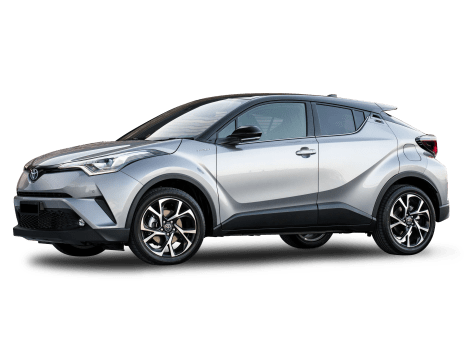
While not looking particularly spacious, there is more than enough room for four adult passengers aboard the C-HR. The rear seats are set high enough that my knees won't dig into the back of the seat when set to my driving position and there's enough headroom for our 186cm (six-foot-one) son. Only problem with the back seat is that the upswept window line leaves an expanse of grey plastic next the occupants' heads, leading to mild claustrophobia.
The front passengers score two cupholders in the centre console and slim door pockets that might squeeze a very small bottle, but I'd hesitate to call them bottle holders. Rear seat passengers have cup holders that will double as a bottle holder for up to 600ml.
The boot is a reasonable 377 litres, which puts the C-HR mid-pack. ASX, Qashqai and HR-V are all bigger booted, while the CX-3 and Trax are well behind. Either side of the boot are cubby holes for odds and sods, and if you lift the floor you'll find a decent-sized tub where you could throw phones or wet towels. The space-saver spare means the boot floor is level with the loading lip and you can fold the seats 60/40.
The C-HR doesn't do cheap. At $26,990, the entry C-HR is a row-your-own front-wheel drive (FWD); a handy $6000 more than a bigger Corolla and $7000 more expensive than a manual Mazda CX-3 Neo (which, admittedly, few people actually buy).
Toyota says - and they're not the only company to say this, if you're wondering - mini-SUV buyers aren't interested in the bait-and-switch starter, and walk into the dealer prepped and ready to pay upwards of $30k to put their new baby on the road. Mitsubishi and Nissan agree.
Toyota is also offering a HiLux-load of genuine accessories and options.
The Koba AWD I had for the week is way over that, though. At $35,290, you're right at the top of the range. Standard are 18-inch alloys, a six-speaker stereo with bluetooth and USB, leather accented seats, auto LED headlights, dual-zone climate control (with Toyota's nanoe air... er... moisturising and filtering tech), reversing camera, keyless entry and start, front and rear parking sensors, active cruise control, sat nav, comprehensive safety package, heated front seats and auto wipers.
The sat nav and media system is run through a titchy 6.1-inch touchscreen and, somewhat predictably, lacks Apple CarPlay or Android Auto, which is kind of what the target market wants. It's a cheap and nasty double-DIN unit familiar from other Toyotas and is Just Not Good Enough, especially at this price point. The USB cable port is in the fascia, so sticks out of the dash. Mazda's CX-3 has a properly integrated unit at a much lower price, and even Honda's creaky old system has the USB port hidden away.
Toyota is also offering a HiLux-load of genuine accessories and options (okay, not quite as many as the big ute, but close), with eight wheel designs, coloured sticker packs (no, really), side steps, various body bits, racks to carry gear for different sporty types and the usual mud guards, wind deflectors, protective mats and two-tone paint jobs, just like this black and gunmetal Koba.
Toyota has plumped for a 1.2-litre four cylinder turbo, developing a modest 85kW and still more modest 185Nm. Even by this segment's standards, that's low. Like its Japanese compatriots (Qashqai, HR-V and ASX), the C-HR also has a continuously variable transmission (CVT) with seven artificial steps in for good measure. CVTs work well with these kinds of numbers, although the 1500kg kerb weight might have something to say about it.
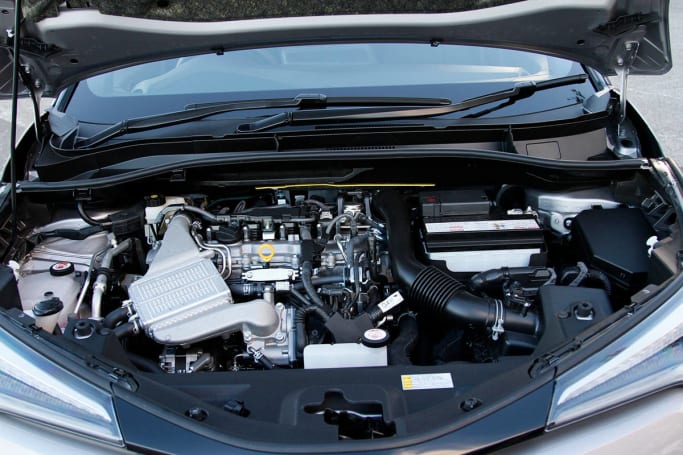
On the official combined (urban/extra urban) cycle, the C-HR consumed the good stuff (95 RON, unusual for a Toyota) at the rate of 6.5L/100km. A mixture of suburban pedalling and a 250km round-trip run from southern Sydney up to the Blue Mountains scored us an indicated 7.7L/100km, which is commendably close.
Let's kick off with the good stuff, and a declaration. This is the best of the segment by some margin. When you're up against the fun of the (much lighter) CX-3, that's an achievement. The steering, while a little light on-centre, weights up nicely in the corners and the grip from the all-wheel drive means you can push pretty hard while feeling secure on the slippery stuff.
The sense of refinement is impressive, again outgunning the best in class.
This is not standard Toyota talk. Most of the time we spend few words on the handling of a Toyota, settling on 'competent.' This is better than competent, it's fun, and it encourages you to have fun while also riding smoothly.
It's also remarkably quiet. While bumps will get you a thunk, tyre noise invades the cabin only when the surface is really bad. The sense of refinement is impressive, again outgunning the best in class (in this case, Qashqai). Somebody has woken up at Toyota and, thankfully, that person is company president Akio Toyoda who in 2014 vowed to spice things up. The C-HR has taken this long because the engineering team wanted to use the new global platform that was in the pipeline, and it was the right decision.
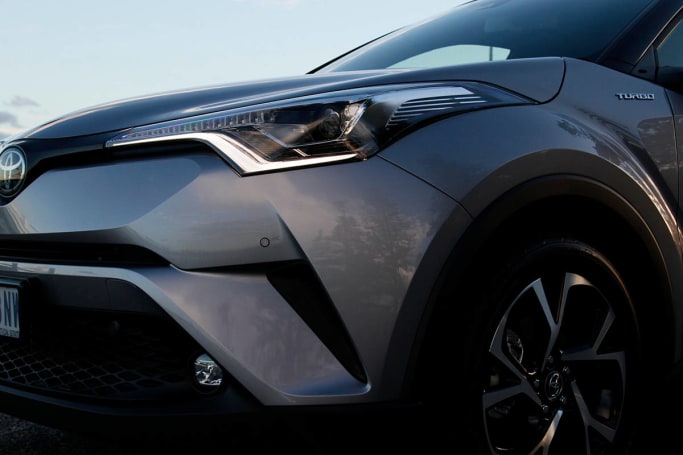
But. And here's the big but. The Koba AWD is achingly slow. While the 1.2-litre engine's 85kW isn't bad for its size (and Peugeot has proved you can do a lot with an engine this small), it's also dragging a kerb weight comfortably 200kg more than its obvious nemesis, the CX-3 (in AWD form) and 150kg heavier than the front-wheel drive Koba - which is also a reasonable $2000 cheaper). Further to that, it has a CVT which, while a big step forward for Toyota CVTs, isn't a particularly good transmission for this relative heavyweight.
Don't get me wrong - it dealt comfortably with the climb up the Blue Mountains, surfing the torque, the engine revving away quietly while the transmission kept it in the sweet spot. The C-HR needs to lose some weight, switch to a proper six-speed auto and gain at least 20kW and 20Nm.
Better still, let TRD loose on it and give the chassis the grunt it deserves. No, the rest of the segment doesn't feature a fireball, but young people don't want a slow car. The Americans get a 116kW 2.0-litre engine and they voted in Donald Trump. Why do they get to have nice things after doing that to the world?
Basic Warranty
3 years / 100,000 km warranty
ANCAP Safety Rating

All C-HRs arrive with seven airbags, ABS, stability and traction controls, lane departure warning with steering assist, blind spot warning and auto high beam dipping. There is also AEB but for some reason it doesn't work under 20km/h but you will get a beep if the car in front is getting too close for comfort. Reverse cross traffic alert will also stop you backing into passing car park traffic.
All Toyotas come with a three-year/100,000km warranty
Along with the warranty (and excellent reputation), Toyota is starting the C-HR on a five-year capped price servicing regime. For those 60 months, scheduled services will cost no more than $195, which is a dead-set bargain, especially when you'll only see the dealer once every 15,000km or 12 months.
With the smashed avocado-eating youth squarely in its sights, the C-HR juggles - but thankfully doesn't drop - the ball. The lack of a sensible media system is a continuing sore point across the Toyota range and the refined but slow 1.2-litre turbo might scare a few buyers away. That's a shame because one of those two things is painfully simple to fix - the cheapie Holden Trax has a better media system.
However, the C-HR proves a number of things. The first is that Toyoda-san's claim wasn't hollow. The company will still make boring cars because they make a lot of money and it's only a minority who want true excitement, but there will be more cars like the C-HR. One of the reasons Hyundai and Kia have risen so quickly is because the cars look good and are increasingly filled with the things the kids (and even older people) want.
Secondly, it might be slow but it's still fun to drive, a fact plenty of other cars have proven over the years.
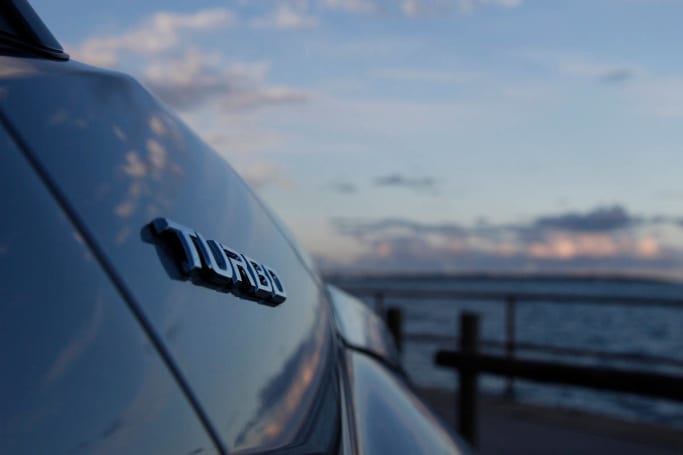
Thirdly it's as good if not better than any car in the segment and, truth be told, as good as anything from Europe currently on sale for yet more money. Toyota are going to sell a ton of these, probably at the expense of Mitsubishi, and its initial allocation of 6000 must be dwindling rapidly. It's not cheap but you get what you pay for - an excellent, capable, high quality and fun mini-SUV. Even if Toyota won't call it that.
| Vehicle | Specs | Price* | |
|---|---|---|---|
| (AWD) | 1.2L, PULP, CVT AUTO | $20,790 – 26,290 | 2017 Toyota C-HR 2017 (AWD) Pricing and Specs |
| (2WD) | 1.2L, PULP, 6 SP MAN | $18,040 – 22,880 | 2017 Toyota C-HR 2017 (2WD) Pricing and Specs |
| Koba (2WD) | 1.2L, PULP, CVT AUTO | $22,770 – 28,160 | 2017 Toyota C-HR 2017 Koba (2WD) Pricing and Specs |
| Koba (awd) | 1.2L, PULP, CVT AUTO | $24,200 – 29,920 | 2017 Toyota C-HR 2017 Koba (awd) Pricing and Specs |
| Design | 8 |
|---|---|
| Practicality | 6 |
| Price and features | 7 |
| Under the bonnet | 7 |
| Efficiency | 7 |
| Driving | 7 |
| Safety | 8 |
| Ownership | 7 |
$16,958
Lowest price, based on 120 car listings in the last 6 months